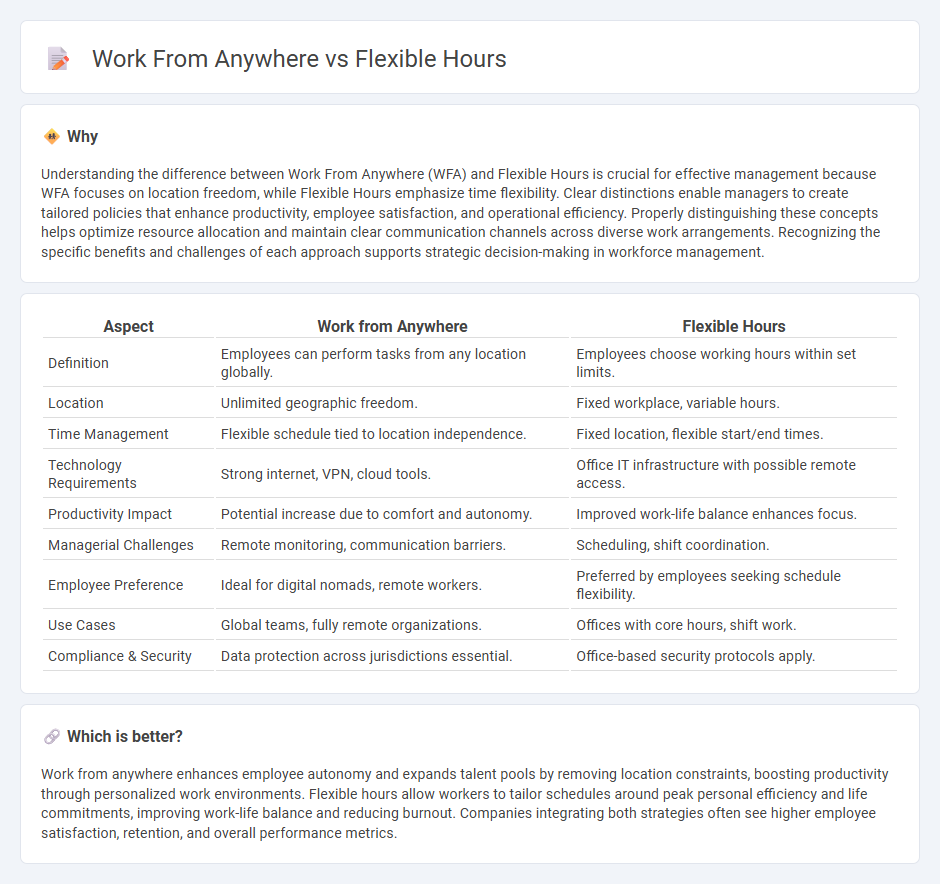
Work from anywhere enables employees to choose their workspace freely, boosting productivity and job satisfaction through geographic flexibility. Flexible hours allow individuals to tailor their work schedules to personal needs, enhancing work-life balance and reducing burnout. Discover how these management strategies transform organizational culture and employee performance.
Why it is important
Understanding the difference between Work From Anywhere (WFA) and Flexible Hours is crucial for effective management because WFA focuses on location freedom, while Flexible Hours emphasize time flexibility. Clear distinctions enable managers to create tailored policies that enhance productivity, employee satisfaction, and operational efficiency. Properly distinguishing these concepts helps optimize resource allocation and maintain clear communication channels across diverse work arrangements. Recognizing the specific benefits and challenges of each approach supports strategic decision-making in workforce management.
Comparison Table
| Aspect | Work from Anywhere | Flexible Hours |
|---|---|---|
| Definition | Employees can perform tasks from any location globally. | Employees choose working hours within set limits. |
| Location | Unlimited geographic freedom. | Fixed workplace, variable hours. |
| Time Management | Flexible schedule tied to location independence. | Fixed location, flexible start/end times. |
| Technology Requirements | Strong internet, VPN, cloud tools. | Office IT infrastructure with possible remote access. |
| Productivity Impact | Potential increase due to comfort and autonomy. | Improved work-life balance enhances focus. |
| Managerial Challenges | Remote monitoring, communication barriers. | Scheduling, shift coordination. |
| Employee Preference | Ideal for digital nomads, remote workers. | Preferred by employees seeking schedule flexibility. |
| Use Cases | Global teams, fully remote organizations. | Offices with core hours, shift work. |
| Compliance & Security | Data protection across jurisdictions essential. | Office-based security protocols apply. |
Which is better?
Work from anywhere enhances employee autonomy and expands talent pools by removing location constraints, boosting productivity through personalized work environments. Flexible hours allow workers to tailor schedules around peak personal efficiency and life commitments, improving work-life balance and reducing burnout. Companies integrating both strategies often see higher employee satisfaction, retention, and overall performance metrics.
Connection
Work from anywhere and flexible hours both empower employees to manage their tasks based on personal productivity peaks and lifestyle needs, enhancing overall job satisfaction and efficiency. Integrating these approaches in management reduces commute stress and fosters a results-oriented culture, improving retention rates and business performance. Companies adopting remote work policies alongside flexible scheduling often experience increased innovation and employee engagement through greater autonomy.
Key Terms
Autonomy
Flexible hours empower employees to choose when they work, enhancing time management and personal productivity, while work from anywhere grants location independence, promoting a better work-life balance and expanded autonomy. Companies embracing these policies report higher employee satisfaction and retention rates, particularly in remote and hybrid settings. Discover how adopting flexible hours and work-from-anywhere models can transform your organizational culture and performance.
Productivity
Flexible hours allow employees to tailor their work schedule to peak productivity times, leading to improved focus and efficiency. Work from anywhere provides geographic freedom, which can reduce commute stress and increase job satisfaction, but may require strong self-discipline to maintain consistent output. Discover how integrating both approaches can maximize productivity and employee well-being.
Work-life balance
Flexible hours allow employees to adjust their work schedules to better fit personal commitments, reducing stress and enhancing overall productivity. Work from anywhere offers the freedom to choose any location, promoting a balanced lifestyle by eliminating commute times and enabling a personalized work environment. Explore how combining these options can maximize your work-life balance and boost job satisfaction.
Source and External Links
What Are Flexible Hours and Why Employers Should Consider ... - Flexible hours are work schedules allowing employees to choose their start and end times, with types including flextime, flexspace, compressed workweek, job sharing, work sharing, and phased retirement, often framed around core hours when presence is required.
Flextime - Wikipedia - Flextime is a flexible working schedule where employees can adjust their daily start and finish times within set core hours, providing adaptability around a required total working time and offering benefits like avoiding rush hour and managing personal commitments.
What Does Flexible Hours Mean? | Indeed.com - Flexible hours mean having different start and end times from the typical 9 to 5, allowing employees to better balance work and personal life by choosing work hours that fit their needs, subject to employer agreement.
 dowidth.com
dowidth.com